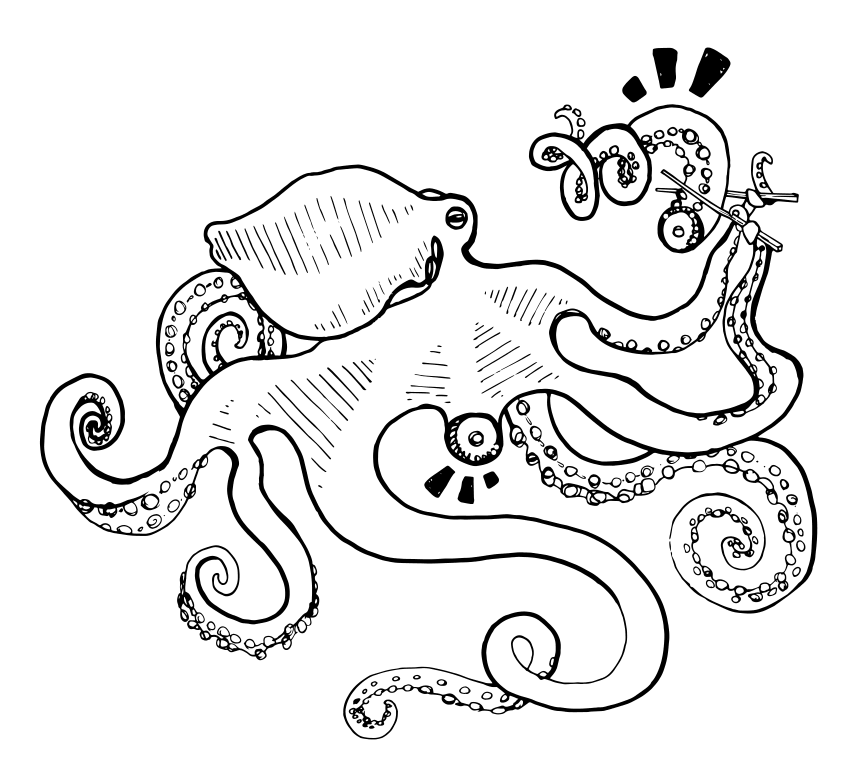The octopus eats its own leg: the title of the Murakami exhibit, on display at the Vancouver Art Gallery, reviewed in this edition’s feature by Mitch Huttema.
The title of the exhibit, Huttema notes, comes from a Japanese idiom meaning to sacrifice or feed on oneself to survive hard times. Apparently an octopus, to avoid starvation, will eat itself.
“The gallery was titled with the interpretation of the phrase because of the significance of this procedure to the way Murakami runs his practice,” according to Huttema.
Huttema writes of Murakami that his “creative strategy” is to set rigid deadlines for himself. Last minute impending, filled by deadline angst, and inspired by the feeling of it, he awakens brilliant and surprising ideas.
Reading this, I recognized something.
It’s striking how so often, self-cannibalism is the road out of failure, toward success. This explanation that Murakami provides as part of the installation elucidates the reality of a demanding world.
Derek Thompson, writing for The Atlantic questions why so many of us feel swamped and overwhelmed, yet data shows a trend of increased leisure time.
“[W]e’re working less than we did in the 1960s and 1980s and considerably less than we did in the agrarian-industrial economy.” It turns out there’s a global decline of annual worked hours. I’d suggest that there’s a cultural decline of another kind as well.
Thompson adds that “there isn’t much evidence in the time-use survey data to suggest that we spend considerably more time on work and chores than we used to.”
Certainly, there are plenty of speculations as to why people feel busier. Perhaps, as some note, we’re a more affluent society and we perceive our time to be of more worth, as it’s increasingly a targeted commodity — space to be colonized by you name it.
I hear busyness as the heralded excuse for many things, among them, not creating art, folk or otherwise. It’s tragic that so many people feel overwhelment. With busyness comes a lessened investment in art for the sake of itself. It’s tragic that aesthetics aren’t inherent in craftsmanship but purposed to sell you crap.
I’m reminded of Herbert Read’s “Pots and Pans,” of his essay, “To Hell With Culture.”
Read asserts that if a society can’t create beautiful pots and pans with the ease it grows potatoes (and we’ve certainly improved our potato, corn, wheat, etc., yield), it won’t be capable of creating higher forms of art. Higher, I’ll note, as expansive, not in the loftier or inaccessible sense of traditional high art.
How true that seems to be.
I look at my pots and pans. The two I inherited have lasted two generations; the several I bought are apparently toxic from overuse.
“The whole of our capitalist culture is one immense veneer: a surface refinement hiding the cheapness and shoddiness at the heart of things,” Read writes. All things must be built for profit, all our actions mapped by margins, and our lives measured in debit and credit. (Almost seems a fantasy to measure a life with coffee spoons.)
As one who works in this era, I suspect Murakami as artist, knows this.
But I find his “wait to the last minute” method conflicting, being that it purposes busyness for creation. Yet it’s incumbent on the work, not because it allows him, as he says, to create beauty under pressure, but because it’s a performance of criticism against a society of busyness. Whether it mocks it, just condones it, or even praises it from Murakami’s perspective, that it’s a part of the exhibit means it’s a part of the artwork. In the context of this increased leisure / increased business culture, I think it’s one of the more remarkable aspects of the piece.
I’ll praise Murakami and condemn his method, though we’re thankful because of it. The artist’s practices aren’t infallible, and in the case of Murakami’s, as with most of the world I’m familiar with, I think it’s a dangerous and flawed methodology. At least, in this era of perceived busyness and demands.
“If we return to our pot and think of the delicate balance of the senses of sight and touch which must guide the potter as the clay turns between his finger-tips, we get some idea of the individual factors involved in all creative activity. If we then remember that the potter must direct the work of his senses towards some useful end — for the pot must function — we get some idea of the social factor involved in all creative activity.”
The case may be that busyness disturbs the finger that makes the pot beautiful. If so, a return to creating beautiful pots is as much the antidote as it is the goal.
 Image: Caleb Campbell/The Cascade
Image: Caleb Campbell/The Cascade


